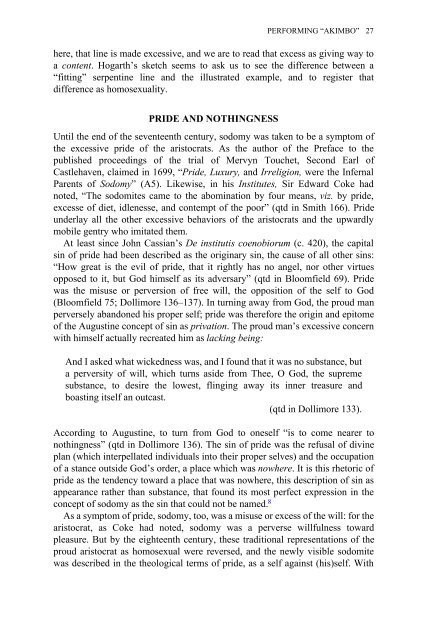Edited by Moe Meyer - Get a Free Blog
Edited by Moe Meyer - Get a Free Blog
Edited by Moe Meyer - Get a Free Blog
Create successful ePaper yourself
Turn your PDF publications into a flip-book with our unique Google optimized e-Paper software.
here, that line is made excessive, and we are to read that excess as giving way to<br />
a content. Hogarth’s sketch seems to ask us to see the difference between a<br />
“fitting” serpentine line and the illustrated example, and to register that<br />
difference as homosexuality.<br />
PRIDE AND NOTHINGNESS<br />
PERFORMING “AKIMBO” 27<br />
Until the end of the seventeenth century, sodomy was taken to be a symptom of<br />
the excessive pride of the aristocrats. As the author of the Preface to the<br />
published proceedings of the trial of Mervyn Touchet, Second Earl of<br />
Castlehaven, claimed in 1699, “Pride, Luxury, and Irreligion, were the Infernal<br />
Parents of Sodomy” (A5). Likewise, in his Institutes, Sir Edward Coke had<br />
noted, “The sodomites came to the abomination <strong>by</strong> four means, viz. <strong>by</strong> pride,<br />
excesse of diet, idlenesse, and contempt of the poor” (qtd in Smith 166). Pride<br />
underlay all the other excessive behaviors of the aristocrats and the upwardly<br />
mobile gentry who imitated them.<br />
At least since John Cassian’s De institutis coenobiorum (c. 420), the capital<br />
sin of pride had been described as the originary sin, the cause of all other sins:<br />
“How great is the evil of pride, that it rightly has no angel, nor other virtues<br />
opposed to it, but God himself as its adversary” (qtd in Bloomfield 69). Pride<br />
was the misuse or perversion of free will, the opposition of the self to God<br />
(Bloomfield 75; Dollimore 136–137). In turning away from God, the proud man<br />
perversely abandoned his proper self; pride was therefore the origin and epitome<br />
of the Augustine concept of sin as privation. The proud man’s excessive concern<br />
with himself actually recreated him as lacking being:<br />
And I asked what wickedness was, and I found that it was no substance, but<br />
a perversity of will, which turns aside from Thee, O God, the supreme<br />
substance, to desire the lowest, flinging away its inner treasure and<br />
boasting itself an outcast.<br />
(qtd in Dollimore 133).<br />
According to Augustine, to turn from God to oneself “is to come nearer to<br />
nothingness” (qtd in Dollimore 136). The sin of pride was the refusal of divine<br />
plan (which interpellated individuals into their proper selves) and the occupation<br />
of a stance outside God’s order, a place which was nowhere. It is this rhetoric of<br />
pride as the tendency toward a place that was nowhere, this description of sin as<br />
appearance rather than substance, that found its most perfect expression in the<br />
concept of sodomy as the sin that could not be named. 8<br />
As a symptom of pride, sodomy, too, was a misuse or excess of the will: for the<br />
aristocrat, as Coke had noted, sodomy was a perverse willfulness toward<br />
pleasure. But <strong>by</strong> the eighteenth century, these traditional representations of the<br />
proud aristocrat as homosexual were reversed, and the newly visible sodomite<br />
was described in the theological terms of pride, as a self against (his)self. With


